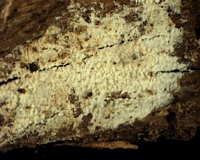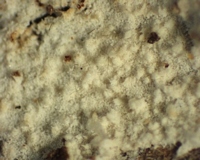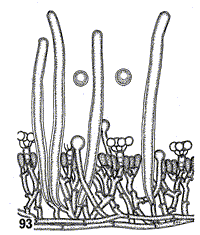|
 Tubulicrinis callosus Tubulicrinis callosus
BiostatusPresent in region - Indigenous. Endemic
Images (click to enlarge)
Caption: Tubulicrinis callosus, BCP 783
Owner: B.C. Paulus | 
Caption: Tubulicrinis callosus, BCP 783
Owner: B.C. Paulus | 
Caption: FIG. 93. Tubulicrinis callosa. Showing the naked cystidia expanding from bases to
apices, with walls becoming progressively thinner towards apices, capitate
paraphysate hyphae, and globose spores. |
Article: Cunningham, G.H. (1963). The Thelephoraceae of Australia and New Zealand. New Zealand Department of Scientific and Industrial Research, Bulletin 145: 359 p. Wellington:.
Description: Hymenophore annual, membranous, adherent, effused forming irregular areas to 10
x 4 cm; hymenial surface white, soon cream, verruculose, tuberculate, not creviced;
margin thinning out, arachnoid, white, adherent. Context white, to 35 µ thick, basal
layer of a few repent hyphae, intermediate layer of scanty erect hyphae embedding
numerous stellate crystals; generative hyphae 3-3.5 µ diameter, walls 0.2 µ thick,
naked, with clamp connections. Cystidia projecting for the greater part of their
length, arising from the base of the hymenial layer, cylindrical or irregularly so, 90-120 x 7-9 µ,
walls naked, to 2 µ thick at bases, tapering gradually to apices.
Hymenial layer to 20 µ thick, a scattered palisade of basidia, paraphyses, cystidia,
and paraphysate hyphae. Basidia subclavate, 10-12 x 4-4.5 µ, bearing 2-4 spores;
sterigmata arcuate, slender, to 5 µ long. Paraphyses subclavate, 6-10 x 3.5-4 µ.
Paraphysate hyphae arising from the hymenial layer when projecting for the greater
part of their length, 30-70 x 4-6 µ, apices inflated to 12 µ. Spores globose or
subglobose, a few oval, some apiculate, 5-6 µ diameter, or 6.5 x 5 µ, walls smooth,
hyaline, 0.1 µ thick.
Habitat: HABITAT: Effused on bark of dead trunks and branches.
Distribution: TYPE LOCALITY: Ahaura, Nelson, New Zealand.
DISTRIBUTION: New Zealand
Notes: Specific features are the subglobose or globose smooth spores, long cylindrical
cystidia with naked walls becoming progressively thinner towards apices, and large
capitate paraphysate hyphae some bearing acicular crystals. Cystidia resemble those
of T. subalutacea, capitate paraphysate hyphae those of T. rimicola.
|